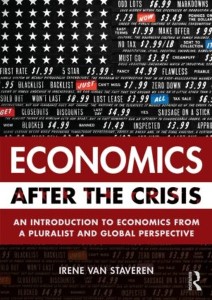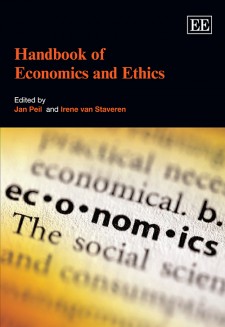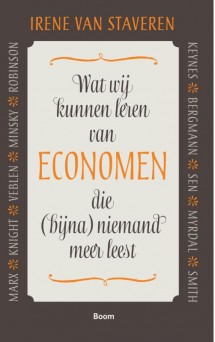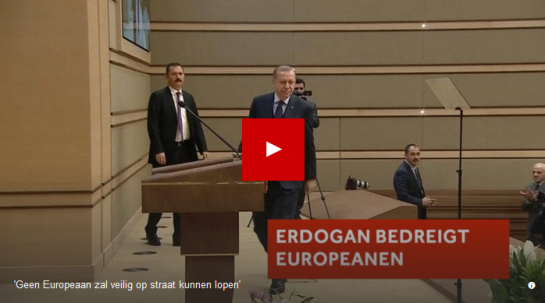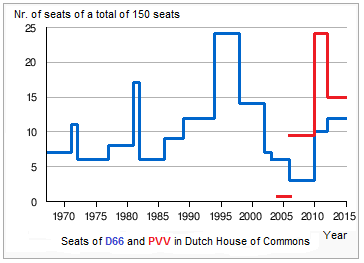There has been discussion whether SARS-CoV-2 (Covid-19) can spread via aerosols, i.e. by particles much smaller than droplets from the mouth and sneezing. The main study is Van Doremalen et al. (2020) (April 16), who write:
“Our results indicate that aerosol and fomite transmission of SARS-CoV-2 is plausible, since the virus can remain viable and infectious in aerosols for hours and on surfaces up to days (depending on the inoculum shed).”
The study was done with a rotating Goldberg drum that turned for 3 hours so that the virus made quite some distance. These authors clearly state: “SARS-CoV-2 (…) can remain (…) infectious in aerosols”
On the other hand, there is RIVM, the Dutch CDC, and its outbreak management team (OMT). The view by RIVM is here (OMT May 15 and RIVM May 27). They refer to studies that would not prove influence with certainty, in particular for SARS-CoV-2, and then they conclude that, while there is some evidence, there still is insufficient evidence for such influence.
“In conclusion, there is currently insufficient evidence whether the virus can be spread over a longer distance, then is infectious indeed and can lead to infections.” (“Concluderend is er op dit moment nog onvoldoende bewijs of het virus over langere afstand verspreid kan worden, dan daadwerkelijk infectieus is en tot besmettingen kan leiden.”)
Remarkably, OMT / RIVM refer to Van Doremalen et al. (2020) but do not provide counter-evidence that the latter would be insufficient. Thus it is false when OMT / RIVM state that there would be “insufficient evidence”. OMT / RIVM gives a wrong summary of the literature.
What is happening here ?
Confusion by minks / ferrets at a small distance
Apparently OMT / RIVM got itself into a tangle on the situation that minks / ferrets in Holland were found to infect humans, see Richard et al. (2020) here. The researchers put ferrets in cages 10 cm apart and observed transmission by air. One of the authors of the Richard et al. (2020) is Marion Koopmans, who is also member of the OMT. OMT / RIVM state:
“In both studies, however, the distance between the ferrets was small, making it impossible to determine with certainty whether the dispersal was via aerosols or droplets.” (“In beide studies was de afstand tussen de fretten echter klein, waardoor niet met zekerheid kan worden vastgesteld of de verspreiding via aerosolen of druppels heeft plaatsgevonden.”)
However, here OMT / RIVM focus on the laboratory setup of Richard et al. (2020) with the limited range of 10 cm, while they forget about the wider implications of the Van Doremalen et al. (2020) study valid for a larger distance. Apparently Richard et al. want to make sure that everybody understands that 10 cm is not 1.5 meter. However, they lose perspective.
It is rather curious that the Van Doremalen et al. (2020) study gets so misrepresented.
Distinction between having a property and showing a property
Both Richard et al. (2020) and OMT / RIVM refer to Van Doremalen et al. (2020). Richard et al. (2020) infer from the Van Doremalen et al. study:
“In a recent study, SARS-CoV-2 remained infectious in aerosols for at least 3h after aerosolization at high titers in a rotating drum, comparable to SARS-CoV [ref]. Although it is informative to compare the stability of different respiratory viruses in the air, our study provides the additional information that infectious SARS-CoV-2 particles can actually be expelled in the air and subsequently infect recipients.”
Thus, while Van Doremalen et al. (2020) speak about being “infectious“, Richard et al. (2020) claim that “actually infect” would be something different, as if “infectious” does not mean that the virus can infect.
It is like the distinction of an apple being nutritious and an apple actually nourishing me.
The verbal distinction of course exists. However, it has no material impact here.
Conclusion: OMT / RIVM distort the scientific evidence. Let them please repair.
Other evidence
For completeness, let us look at some other evidence.
1. In the actual mink / ferret farms, the corridor between the cages may well be 1.5 meters wide, see this picture. There was no report that ferrets got only infected in particular rows. Likely there was wholesale spread over entire barns, perhaps though spread by humans walking in the alleys.
2. There is the air ioniser. Dutchman Ton Rademaker claims that he alerted some Chinese hospitals to the problem of ventilation and the solution of ionisation and that they tried this and that it worked. Rather than dismiss this, one would want this checked. The wikipedia article on the air ioniser refers to this peer reviewed article on reducing air-borne transmission: Hagbom et al. (2015), who state: “Most importantly, we demonstrate that this technology can be used to prevent airborne-transmitted influenza virus infections.” See from there to articles about airborne infections.
Scientific curiosity
Potentially the discussions of OMT / RIVM involve so many people and aspects that the result becomes something like the product of a legal accountant. Instead, a scientific researcher would check the observational or experimental setups, check what information is missing, and design an experiment to prove or disprove the hypothesis. One would not take SARS-CoV-2 because of its potential lethal property but a common cold. Okay, if you want to kill ferrets, then you have a license to use SARS-CoV-2, and see whether you can create aerosols for a distance of 1.5 meter. One could calculate how much the experiment would cost and how long it would take. It is remarkable that OMT / RIVM does not show this scientific interest and doesn’t commission such research. One gets the impression that they were asked about their earlier view, and that they are only interested in restating their earlier view, instead of opening up to alternative views and searching for contrary evidence. In the above I only supposed that they were distracted by the 10 cm distance between the ferret cages, and wanted to make it really clear that 10 cm is no 1.5 meter. Still, it is a remarkable scientific error and perhaps there were also other influences.
(One might propose that if they really think that it hasn’t been proved, then infect the air conditioning system of the university with some virus, and see what happens. Ah yes, you cannot experiment on people, even if it is the common cold, but it is fully acceptable to allow a potentially lethal virus to run around in society with the purpose of “building up herd immunity”.)
Employer associations on air ventilation
It must be mentioned that Techniek Nederland and NVKL, organisations of producers and installers of ventilation systems, refer to the RIVM report. These organisations repeat the conclusion that it hasn’t been proven that such systems can transfer the virus. This is very much like arguing that it hasn’t been proven that the Virgin Mary didn’t have an immaculate conception because nobody, and especially not the Pope, provided evidence that it happened differently. Precisely the organisations that should provide customer support join RIVM in what runs against common sense. It is not necessarily in their interest: because adapting such installations would provide for much employment. Perhaps they are afraid for legal action that they are guilty of causing infections by selling unsafe installations ? Dutch TV on the evening of June 24 had the railways CEO explain that people cannot open the windows in the train but that the railways were looking for improvements of the ventilation system (apart from opening doors at stations). It is a serious issue, and RIVM makes a curious scientific error here.
Maurice de Hond
I came upon this topic via Maurice de Hond, an opinion pollster with a background in “human geography”. He is livid that RIVM denies the importance of aerosols, ventilation and air conditioning.
An important argument by De Hond refers to the observation that 10% of the cases might infect 80% of the next generation. Thus the R0 for the 10% will be much higher than the average. RIVM instead clings to the average:
“Also an R0 of 2-4 does not seem to indicate aerosol distribution and a substantial contribution to the direct human-to-human transmission of SARS-CoV-2 (ECDC rapid risk assessment April 23, 2020)” Dutch: “Ook een R0 van 2-4 lijkt niet te wijzen op aerogene verspreiding en op een wezenlijke bijdrage aan de directe mens-op-menstransmissie van SARS-CoV-2 (ECDC rapid risk assessment 23 april 2020)”
Conclusion
The above explains the error by RIVM. Let they please correct.
(It would be interesting whether RIVM has been presenting this view with ECDC and what their reaction has been.)
Addendum June 26
It now appears that KNAW had a webinar on the issue on June 4, with moderator Detlef Lohse, and four other speakers on fluid dynamics. The Guardian referred to a report on the air cooling system of a German slaughterhouse. One would hope that RIVM comes around soon, and before the Fall when people spend more time indoors. A Dutch magazine report is here.
Addendum July 6
(1) RIVM updated its argumentation on June 30. They rephrase to:
“We state that, based on current insights, it is unclear whether aerosol transmission plays a role in the spread of SARS-CoV-2. Dutch: “We stellen dat op basis van de huidige inzichten onduidelijk is of aerogene transmissie een rol speelt in de verspreiding van SARS-CoV-2.”
This is a vacuous statement, using their authority only, since they do not state what condition must be satisfied before things are clear to them. It is unclear why RIVM rephrased their position while they say the same on content.
(2) There are Morawska et al. (2020) with 239 scientists who argue for more attention to aerosol transmission in the regulations of the various countries. Sadly, they weaken the case, by stating, without clarifying what would be missing:
“The evidence is admittedly incomplete for all the steps in COVID-19 microdroplet transmission, but it
is similarly incomplete for the large droplet and fomite modes of transmission. The airborne
transmission mechanism operates in parallel with the large droplet and fomite routes, e.g. [16] that
are now the basis of guidance. Following the precautionary principle, we must address every
potentially important pathway to slow the spread of COVID-19.”
Thus we see 239 scientists shooting themselves in the foot. What evidence is incomplete ? It is absurd to invoke the precautionary principle against murder when the dead body of the victim lies before you. There is a crucial distinction between science and philosophy, as a philosopher might ask: “What is “dead” ?”
PM. My attention to the 239 scientists was drawn by this article by (unreliable) Maarten Keulemans. He spoke with one of the Dutch signatories, Philomena Bluyssen:
“We believe that especially as we return to the old situation, aerosol transmission should be recognized as an equally relevant route.” Dutch “Wij vinden dat met name nu we weer teruggaan naar de oude situatie, aerosole transmissie als volwaardige route moet worden erkend.”
(3) Ab Osterhaus agrees with De Hond that measures against aerosol transmission may help, must be tried, and must not be discounted as an investment loss (Medisch Contact). This again is the precautionary motive, while De Hond points to the superspreading events, and the option that direct human contact (say between family members who visit their grandparents in a care home) might be feasible if other precautions are taken.
Addendum July 7
Jack Schijven et al. (2020) have this (non-peer-reviewed) article on medRxiv July 5: “Exposure assessment for airborne transmission of SARS-CoV-2 via breathing, speaking, coughing and sneezing”. This is a Monte Carlo simulation that uses observed (boundary) profiles and phenomena and their estimated parameters to run a model of how actually unobserved airborne transmission might occur. It is quite remarkable how the human biology may be modeled. A remarkable meta-observation is that the authors are affiliated with RIVM that has been hesitant in acknowledging aerosol transmission. My comments are:
(1) They state:
“Similarly, van Doremalen et al. (2020) also found that SARS-CoV-2 remained viable for hours in experimentally generated aerosols (reduction in infectious virus particles from 3100 to 500 per litre air in 3 hours).” (lines 90)
However, Van Doremalen et al. (2020) state that the virus remains *** infectious ***. Indeed, Schijven et al. later state:
“Because short time frames are considered, and SARS-CoV-2 has been observed to remain infectious in aerosols for hours (Fears et al. 2020; van Doremalen et al. 2020), decay over time is not modelled in this study. The exposure assessment will, in that regard, be conservative. ” (lines 250)
My suggestion is that they replace the first “viable” with “infectious” too, because there is a risk that you might be quoted selectively. If they don’t believe Van Doremalen et al. (2020), and want to change the latter “infectious” with “viable” too, Schijven et al. should first check with Van Doremalen et al. whether they did use e.g. a culture plate with human cells or lab animal indeed, and Schijven et al. then should report about this check with these authors.
In general a person is infected until the immune system clears the person (even when e.g. HIV goes into hibernation), and the default assumption is that Van Doremalen et al. (2020) are aware of this convention, until peer criticism shows that they have made an untenable claim.
(2) They state:
“To conclude: aerosol transmission of SARS-CoV-2 is possible and should not be disregarded.”
In my judgement, this already shows from Van Doremalen et al. (2020). Schijven ea. do not clarify what their own study adds to this earlier finding. A new study must be more specific about the difference between the earlier finding of “infectious aerosols” and the new finding of the same. If a new study cannot state a relevant criticism, then the new study must state that its finding supports their finding. Please do not leave the puzzle to others.
(3) Schijven ea. first state:
“Furthermore, it should be noted that it is unknown what fraction of airborne RNA-copies is infectious virus. Observational data on infectious virus in aerosols in various settings are needed to validate modelling efforts. No dose-response model is, as of yet, available for SARS-CoV-2. “
and then conclude the same:
“5.As long as it is uncertain what fraction of the airborne RNA copies relate to virus particles and how much of these are infectious and as long as a dose response relation is lacking, it is recommended to be precautious.”
(3a) Basically they now again question whether Van Doremalen et al. (2020) have been competent enough about their use of the word “infectious”.
I can imagine that a particular line of research uses RNA and Ct values to score outcomes and then wonder about the dose response relation, but in general a person is infected until the immune system clears the person, and the default assumption is that Van Doremalen et al. (2020) are aware of this convention, until peer criticism shows that they have made an untenable claim.
Thus, in general my impression is that, the dose-response relation relates to the severity of the disease (e.g. whether healthy nurses may die too), and not to the fundamental point that a person becomes infected.
(3b) What kind of “observational data” would Schijven ea. imagine that can be generated to validate models here ? Follow individually marked aerosols by camera ? Are people (or e.g. trains) to take air samples before people report sick ? It seems that Schijven ea. are imposing an impossible condition. It may indeed sound logical, that you actually want to see proof for something. But if you cannot prove the issue in any practical manner, then this phrasing may cause a lot of confusion, as if first something impossible must be proven. My suggestion is that Schijven ea. state what a practical proof would be, or otherwise clarify that such condition is impractical.
(3c) Their use of the word “precautious” is also in the “discussion” of their abstract. What do Schijven ea. mean by being “precautious” ? Do they mean precautious in saving the economy by not requiring more ventilation, or do they mean precautious in saving people by further locking down the economy before air ventilation has been improved ?
Their ambiguous use of the word “precautious” can be abused by selective quotation by persons or agencies who want to advocate the one or the other.
My suggestion is that authors do not try to think for readers, on what they ought to do or not, but that they give information. It suffices to support the conclusion by Van Doremalen et al. (2020) that there can be aerosol infection, so that agents can adapt guidelines. Agents in the economy then will be alerted to the newly identified risk, and take their own measures and do research until there is more clarity about their own particular situations.
(3d) These authors work at RIVM. I am annoyed that Richard et al. (2020) on ferrets, that they refer to, and that RIVM maltreat the Van Doremalen et al. (2020) study before too. See here:
https://boycottholland.wordpress.com/2020/06/25/sars-cov-2-and-aerosols-and-ventilation/
RIVM has a tendency of making judgements about cost-effectiveness and economic impact without modeling such aspects or consulting with experts on those issues. If RIVM accepts that such aspects are relevant, then widen the circle of such experts, or restrict yourself to what you can say.
(4) Allow me to suggest that Schijven et al. also refer to the website of Maurice de Hond. When you refer to the point that there has been discussion about aerosol transmission then this might be a good place to refer to such discussion in the public domain. De Hond already linked superspreading events to the aerosols and that 20% of people may cause 80% of infections so that their R0 is high and so that the counterargument of RIVM on the average R0 has no relevance. If you are looking for observational studies then you can find some such evidence in that SARS-CoV-2 here is basically like SARS-CoV-1 (Peter Borger).
Addendum July 8
Apparently WHO is now rethinking the role of aerosols. The BBC:
“The World Health Organization has acknowledged there is emerging evidence that the coronavirus can be spread by tiny particles suspended in the air. The airborne transmission could not be ruled out in crowded, closed or poorly ventilated settings, an official said. If the evidence is confirmed, it may affect guidelines for indoor spaces.”
What would they mean by “if the evidence is confirmed” when it has already been confirmed many times over ?


